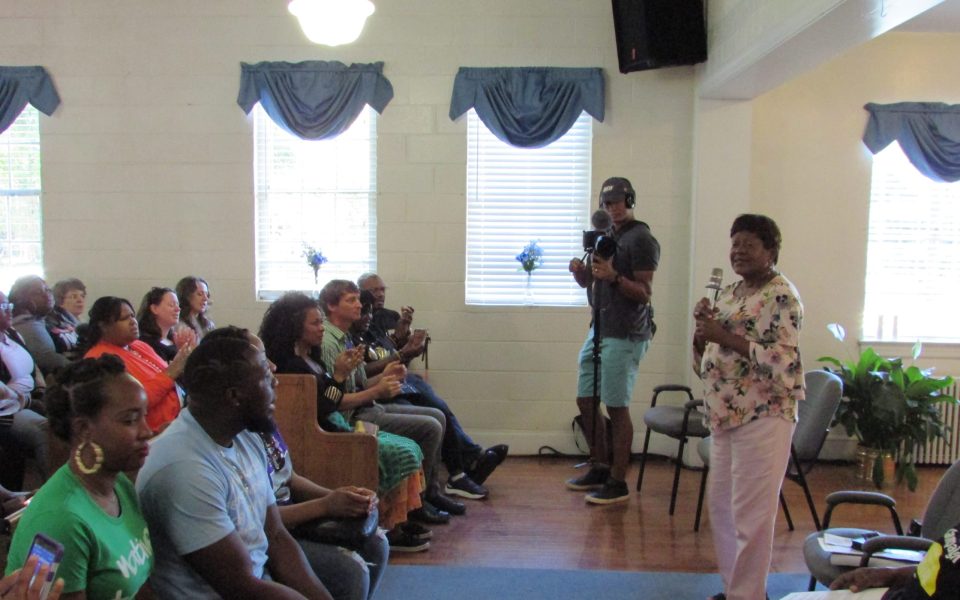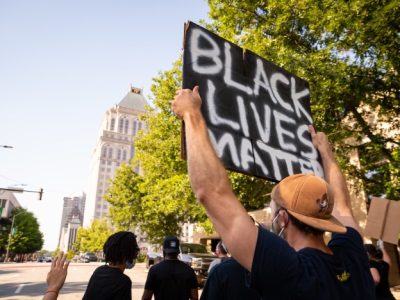Greensboro and Charlottesville, two small Southern cities scarred by racist violence, are inextricably bound by shared tragedy from two barbaric ruptures and the continuing psychic wounds of fear and mistrust that linger — one on Nov. 3, 1979 and the other on Aug. 12, 2017.
Two busloads of residents from Charlottesville and Albemarle County filed into Faith Community Church on Monday during a stop on the Charlottesville Civil Rights Pilgrimage. The delegation, which included Charlottesville Mayor Nikuyah Walker and Susan Bro — the mother of slain antiracist activist Heather Heyer — carried soil gathered from the site in Charlottesville where John Henry James, a black man, was lynched in 1898. By Thursday, they will have deposited the soil at the National Memorial for Peace and Justice in Montgomery, Ala.
But this Monday morning, they listened to the Rev. Nelson Johnson, who lost five friends in a fusillade of bullets fired by a caravan of Nazis and Klansmen who opened fire in a black housing project in Greensboro in 1979. As Johnson described white supremacists promising to come to Greensboro, the violence that took place “in broad daylight and with cameras rolling,” the police showing up several minutes afterwards, and frustration with the legal process, murmurs of “mm hmm” and “sounds familiar” could be heard in the audience.
On the eve of the Aug. 12, 2017 Unite the Right rally, white supremacists with torches surrounded antiracist worshipers in a church. The next day they fought anti-fascist activists with sticks and shields, as the police stood on the sidelines, and viciously beat DeAndre Harris, a young black man, in a parking garage as the rally was breaking up. James A. Fields Jr., who participated in the rally with the white nationalist group American Vanguard, later accelerated his Dodge Challenger into a crowd of antiracist marchers, killing Heyer and injuring several others.
On Monday, Johnson expressed his condolences to Heyer’s mother, and he shared with the audience that Susan Bro told him her daughter’s death “was not in vain, that it opened up an enormous possibility to let the truth flow over Charlottesville, in North Carolina and all over the nation.”
The Johnsons have been fighting to have their truth heard for almost 40 years. After the massacre, they faced hostility from the local political establishment and much of the citizenry, who in many cases were quicker to blame them for standing up to the Klan than the perpetrators of the violence. In 2017, the president of the United States would echo that rhetoric with his assessment that there were “some very fine people on both sides.”
The Charlottesville residents were eager to hear Nelson’s wife, Joyce, describe the atmosphere of fear among the survivors after the Greensboro Massacre.
“Those of us who were immediately impacted did not know whether we would subsequently be killed,” Joyce Johnson said.
With then-Mayor Jim Melvin framing the massacre as a “shootout” and portraying the antiracist activists as “outside agitators,” Johnson said, “All of a sudden we were outsiders. Folk would move because they thought we were the purveyors of the violence. And even those who knew [better] came later and told me: ‘I knew it wasn’t y’all, but I was scared I would get killed.
“We had to move out of our home for safety,” she continued. “Yet when we tried to rent other places people wouldn’t rent to us because they were afraid that Klan and Nazis would show back up. So a bunch of us just huddled into two or three houses. Many of us lost our jobs. I was one of the few people who kept my job. I was on the faculty of the School of Business at A&T. And my dean who was from Alabama, he said he was visited by — it was either the SBI or the FBI; I’m not sure which — and he was ordered to fire me. He said, ‘I’m not. There’s no basis. And I know who the Klan is. I’m from Alabama.’”
Repairing the damage of racial violence is difficult, and genuine reconciliation is tricky. In the mid-2000s, Greensboro hosted the first truth and reconciliation commission in the United States. Reconciliation without an acknowledgement of the harms inflicted by white supremacy can easily turn into mushy kumbaya sentimentality that invites false equivalencies.
Gloria Beard, a Charlottesville resident old enough to remember riding on the back of the bus and marching for civil rights with her mother, talked about a sense of fear that has paralyzed Charlottesville since Unite the Right.
“Why aren’t we participating?” she asked. “It’s about us. If one person’s hurting, then we all are going to be hurting. I don’t care if you go down with a gun or what. We got to stick together. We got to start planning how to start businesses, buy land together and work together. How do we get people to understand this?”
Nelson Johnson’s views on the moral and practical considerations of combating white supremacy have evolved over the years.
“As someone who has really kind of endured the spectrum of organizing, I’ve come to the view that people have the potential of growing out of wherever they are,” he said.
In 1987, when the Ku Klux Klan was planning to return to Greensboro, Johnson traveled as a divinity student to Rowan County to plead with Klan leader Carroll Crawford to not come.
“This was my effort to try to speak to the soul that I had to believe was in there,” he said. “Otherwise my action was to shoot him before he shoots me.”
Although the Klan still came to Greensboro, Johnson was still able to make a human connection with Crawford that he believes made a difference.
“I was fighting for his soul,” Johnson said. “I don’t recommend it for everybody. We have different roles to play. But I had that role to play. Nobody was demonized as much as me, hated as much as me, so I had to confront him with the opposite of his belief so that he had to look me in the eye, and we had to press toward each other.”
Join the First Amendment Society, a membership that goes directly to funding TCB‘s newsroom.
We believe that reporting can save the world.
The TCB First Amendment Society recognizes the vital role of a free, unfettered press with a bundling of local experiences designed to build community, and unique engagements with our newsroom that will help you understand, and shape, local journalism’s critical role in uplifting the people in our cities.
All revenue goes directly into the newsroom as reporters’ salaries and freelance commissions.





Leave a Reply